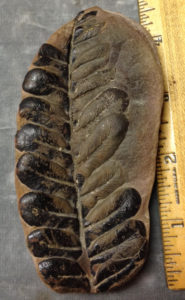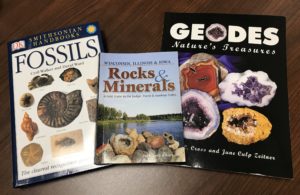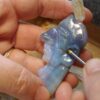Spring 2021

Download our past newsletter
Special Exhibit
Fan Favorites from the Lizzadro Collection
Through August 29, 2021
Missing some of your favorite pieces in the Museum? Re-visit the “Jade” Bi, the 18 Lohans, and the Rock Café!
See works by American lapidaries and the jadeite table screen from the Chang Collection.
Learn fun facts about each piece in the exhibit.
Rockhounding in the Midwest
Sara Kurth, Museum Educator
Last year we had to cancel all of our fossil collecting trips and most likely again this year too. If you’re missing rockhounding as much as we are, we have some hot tips for collecting on your own right here in the Midwest!

Of course, there’s the ever-popular Mazon Creek fossils! The Mazonia-Braidwood State Fish and Wildlife Area is the site of historic Pit 11, where many Mazon fossils have been found. The mounds are remnants of coal mining days, some full of fossil concretions. A day permit is required and fossil hunters can bring a 5-gallon bucket to haul out fossils. Digging is strictly prohibited in this area. Fossil collecting is available between March 1 and September 30. The road out to prime fossil areas is restricted to authorized vehicles only. Due to the site’s popularity, as well as the difficult terrain, fossil collecting at Pit 11 can be quite daunting with little success; however other cool rocks and minerals can be found. Folks with boats may have an easier time reaching more remote locations in the area, but strict rules are in place. For more information about Mazonia-Braidwood SFWA or to obtain a permit, visit: https://www2.illinois.gov/dnr/Parks/Activity/Pages/ Mazonia-Braidwood.aspx.

If you’ve been driving east on 294/80 towards Indiana, you have driven over one of the world’s largest aggregate quarries, Thornton Quarry. This limestone quarry is 450-feet deep, 1.5 miles long, and half a mile-wide. Formed during the Silurian age, approximately 440 million years ago, the limestone is a product of a tropical sea that covered the Chicago region. Within the rocks, ancient sea creatures including coral, crinoids, trilobites, cephalopods, brachiopods, and gastropods have been encased. Thornton Quarry and other Chicago area and Wisconsin quarries have been utilized for construction purposes. Thornton alone produces over seven million tons of rock products (sand, gravel, slag, etc.) a year1. This is the only quarry that is “open” for general tours, although tours happen only on the first Saturdays of June and October and are fully booked through 2022. In order to visit other limestone quarries in the area, folks need to be part of a group, like the tours hosted by the Lizzadro Museum and ESCONI. Most quarries have strict policies regarding individuals who collect in their facilities. Whether or not you live near a quarry, fossils can be found nearly everywhere in Illinois, Iowa, Indiana, Wisconsin and lower Michigan. Just get a good fossil book, look closely at sedimentary rocks, and you will start to see remnants of creatures from long ago.

If you’re willing to travel a bit, the Keokuk geodes in Iowa, Illinois, and Missouri are a rockhounds treasure chest! There are over 300 outcrops, mostly in streambeds, where geodes have been found within 100 miles of Keokuk, Iowa. The Warsaw Formation is a dolomite-rich limestone and mudstone, formed during the Mississippian period, approximately 350 million years ago2. It is still unclear as to why geodes formed, although many interesting ideas abound. The book “Geodes: Nature’s Treasures” gives an excellent interpretation. The Keokuk geodes have inclusions of all varieties, including calcite, pyrite, kaolinite, malachite, and even gas and oil! If you go geode-hunting, you will need to make sure to check with the site you’re visiting as most of the hunting locations are on private property and have specific rules about bringing out geodes. For fee collecting sites, Google geode collecting in Illinois and Iowa.
Our neighbor to the north, Wisconsin, is home to some amazing rocks and opportunities for collecting. If you dig spelunking, then Cave of the Mounds is for you! Less than an hour from Madison, this limestone cave features awesome stalactites and stalagmites, as well as gorgeous hiking trails to see karst topography – the landscapes shaped by cave systems.

Once you’re in Wisconsin, you might as well take a trip to Lake Superior to look for Lake Superior agates! These agates were formed when a volcanic rift began opening in the middle of the United States. This rift produced lava, which covered the basin that is now Lake Superior. Within that lava, vesicles, or air bubbles formed. Over time, those vesicles filled in with silica-rich water, leaving a coating of silica, or quartz within the cavity. These quartz-filled cavities eventually led to the formation of beautiful agates, known as Lake Superior agates. For rock hunters taking a trip along the shores of Lake Superior, spotting an agate can take time and patience, but it is great fun picking through all the other interesting stones along the lakeshore. Due to the glacial activity, Lake Superior agates can be found in Minnesota, Wisconsin, Michigan’s Upper Peninsula, northern Iowa, and even in gravel deposits along the Mississippi River basin.

At first glance, a lot of folks overlook Illinois and the surrounding Midwest as “boring” due to the lack of mountains, earthquakes, and volcanoes. But the geologic history of the upper Midwest is one not left unexplored. We hope to be back to rockhounding again soon, but in the meantime, get out there and explore this amazing area!
References
1. Eisenberg, Paul. “Thornton Quarry transformation part of ‘largest civil engineering project on Earth.’” Northwest Indiana Times, 2015.
2. Cross, Brad L. and June Culp Zeitner. “Geodes: Nature’s Treasures.” Gem Guides Book Co., 2006.
15 Days in May
Members Sale!
Looking for a gift for Moms, Dads and Grads?
Members can double their 10% discount to 20% off
from May 1 thru May 15, 2021.
Come in to the Museum Shop or shop online!
As of March 1, 2021, Dr. Tongyun Yin has left the Lizzadro Museum. We are grateful for her in-depth research of the Lizzadro Collection and help in opening our new location in Oak Brook. We wish her all the best in her new position as Asian Arts curator at the Harn Museum of Art in Gainesville, Florida.
Geocaching Scavenger Hunt

Check out the geocaching scavenger hunt for outdoor fun! Download the “Adventure Lab app from the App Store or Google Play, or visit the website. Once you’re logged on, check out the Museum Adventure Games
and start visiting sites! Each location has questions to be answered – win a prize at certain locations!
Passport to Adventure and Geocaching is sponsored by KDRMA (The Kane DuPage Regional Museum Association).




